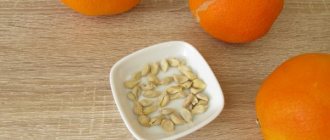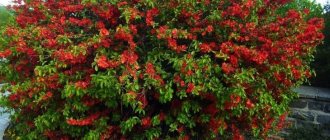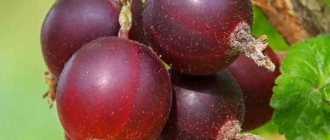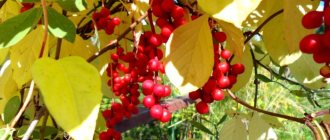In the East, pomegranate is called the royal fruit for its excellent taste and beautiful appearance. One fruit contains most of the nutrients needed by the human body. In folk medicine, pomegranate seeds and peel are used to treat anemia, dysentery, gastrointestinal disorders and other diseases.
Pomegranate trees are grown on an industrial scale in many countries and cities with a subtropical climate. Trees are demanding on the climate, but are unpretentious in care. Where pomegranate is grown, how it grows in nature and when the fruits ripen - read on.
Historical homeland of the plant
This plant has been known to people since ancient times. In ancient Rome, the fruit was called a granular apple. This plant was also loved in Egypt. Indeed, in the vicinity of Carthage there were many gardens with these fruits. Therefore, pomegranate is often called the Carthaginian apple.
The first seedlings were brought to Carthage by the Phoenicians in 825 BC. They sailed from the eastern side of the Mediterranean Sea, because there was active trade in this place. Soon the Romans came to these lands and destroyed everything, leaving only pomegranate gardens.
For a long time, the fruits of these trees were considered the main ones on the royal table. After all, their peel resembled a crown.
Where does pomegranate grow? These trees thrive in subtropical and tropical climates with prevailing droughts. Today this tree grows all over the world. It was brought to the USA and Mexico, and is common in Europe and Asia. You can even see how pomegranates grow in Russia.
How to clean it properly?
Almost everyone peels pomegranates the same way: cut them into two halves, remove the peel and squeeze out the seeds.
This is not entirely correct. Firstly, it takes a lot of time, and secondly, this can damage the pulp. Residents of southern countries, where the “grainy apple” is a common fruit, recommend peeling pomegranates as follows:
- Carefully cut off the “cap” of the fruit.
- Divide the pomegranate along the contours of the white pulp into 4-5 parts (the contours of each fruit may be different).
- Break the fruit along the “marked” contours.
This way, the pomegranate will be divided into beautiful pieces that can be served on the table. This method preserves the integrity of the grains and prevents juice leakage.
Description of the variety
Many people ask whether pomegranate is a fruit or a berry. After all, the fruits of this plant are very similar in shape to an orange or an apple, but inside they have up to 1000 seeds located under a dense peel. According to biological classification, the fruits of this plant are considered berries.
The pomegranate tree reaches 6 m in height. But there are also dwarf varieties in the form of shrubs. The tree trunk is small with thorny and thin branches. The bark of the tree has a light brown tint. How do pomegranates grow? The plant blooms from May to August with large and beautiful flowers. The flower is bell-shaped. Its shades can be different: yellow, white, red-orange.
The fruits are spherical, 12 cm in diameter. Each of them can reach 0.5 kg. Many people are unsure of their judgment and ask the question: “Is a pomegranate a fruit or a berry?” Experts classify the fruits of this plant as berries. Their dense peel can have different shades: brown, yellow-red. The seeds are hidden under the skin in a sweet and sour red shell. They contain many useful vitamins and microelements, acids and monosaccharides, tannins. In one season, about 60 kg of crop can be harvested from one tree.
So where does pomegranate grow? Today this plant is more common in Italy, Greece, the Middle East, the Caucasus and Crimea. This plant is rarely found in wild form.
Benefits of pomegranate juice
“Grainy apple” juice is a concentrated drink, so you can drink no more than 300 ml per day. Benefits of pomegranate juice:
- a mix of vitamins and amino acids allows you to maintain your immune system at its best;
- strengthening nails, teeth and hair;
- stabilization of blood pressure.
Pomegranate juice is not only beneficial, but can also be harmful to health:
- due to the acids contained, it stimulates appetite;
- teeth may darken;
- the appearance of a skin rash is possible.
The main thing is to observe moderation.
Growing conditions
Under what conditions and how do pomegranates grow? The plant requires a lot of light, so ideal conditions for growth are regions with a prevailing hot climate. After all, if there are few sunny days in a year, the pomegranate may not bloom.
To obtain large, juicy and tasty fruits, hot weather is required throughout the summer. In winter, pomegranate leaves fall off. The tree tolerates frosts down to -12°C.
Fruits from a pomegranate tree can be obtained on average for 60 years. But there are also exceptions. For example, in Azerbaijan, pomegranates grow, which have been bearing fruit for 100 years, and in France - 200 years.
Story
Pomegranate in Latin means grainy. The homeland is considered to be ancient Persia, located on the territory of modern Iran. Plants were grown in Ancient Egypt and India. In the Middle Ages, the Spaniards took it to America. Pomegranate is one of the seven fruits that were mentioned in the Bible. Since ancient times, it has had special value for humans; it was depicted on the walls of the tombs of the Egyptian pharaohs and symbolized life after death.
During its existence, it was used for food, making healthy drinks, and coloring leather. A wreath of branches on a woman's head indicated her married status. Over the years, exchanged for money and pieces of furniture. There are many beliefs associated with it. In Persia, during a wedding, there was always a basket of pomegranates on the table as an indicator of prosperity and wealth.
Types and varieties of pomegranate
Many people want such a fruit tree to grow in their garden or in their home. But how to grow pomegranate? First of all, you should understand the variety of varieties of this plant.
According to the classification of plants, pomegranate belongs to the Derbennikov family. At the moment, there are only 2 types of these plants: ordinary and Socotran pomegranate.
Socotra pomegranate grows in only one place - on the island of Socotra. This variety grows on its own; it is not specially planted. After all, it is not characterized by such a pleasant taste as an ordinary pomegranate.
As for the ordinary pomegranate, it is distributed throughout the world. It is found not only in cultivated form, but also in the wild.
Today there are many varieties of pomegranate. Each of them has a specific taste and size of the fruit. Today we will look at varieties that grow in regions close to our state.
Many people ask whether pomegranate grows in Crimea. Yes, the Crimean striped pomegranate variety was created in the Nikitsky Botanical Garden. This is a tree of small height with fruits up to 300 g. The peel of the fruit is thick, the grains are sweet and sour with a dark cherry hue.
- The Gyulosha red and pink variety grows in Azerbaijan. The peel of the fruit is thin, red and pink. The grains are juicier and larger than the previous variety, but more acidic.
- Bala-mursal grows in Azerbaijan. This tree is small in size, up to 3 meters in height. The weight of 1 fruit reaches 500 g. This variety is characterized by high yield. From one bush you can collect 50 kg of sweet and sour fruits per season.
- The Nikitinsky early variety is a small shrub with large fruits. The fruits are juicy, large, sweet with a slight sourness.
- The dwarf pomegranate is an ornamental plant, but its fruits are edible. The weight of one pomegranate does not exceed 100 g, but the taste of the fruit is the same as an ordinary one. The fruits differ from ordinary varieties only in size. The height of the bush reaches 1 m. This variety is suitable for growing at home. This plant blooms already in the first year of life with a tree height of only 25 cm.
- Achik-dona grows in Tajikistan and Uzbekistan. Many people love the large and sweet grains of these pomegranates. The productivity of this variety is high. You can collect 40 kg of fruit from one tree.
Narsharab sauce
Narsharab sauce is intended for fish dishes and kebabs. To prepare 250 g of narsharab, you will need 1 kg of pomegranate seeds. The sauce is a black, viscous oily liquid with the taste of overripe grains.
Pomegranate is generally a very useful plant. Its peel is dried and brewed as tea. It is useful for people with kidney problems. And a very tasty sorbet is prepared from pomegranate flowers. All parts of the pomegranate fruit are processed.
- 6 common mistakes of beginning winegrowers
* * *
I also tried mulberry sauce at a party: it takes a bucket of mulberries to prepare one sauce boat. This sauce tastes amazing and is very sweet. They say it is used as a medicine to cleanse the liver.
Pomegranate at the dacha
Don’t know how to grow pomegranate in your garden? First of all, you should determine the region of your residence. After all, this information will be useful for people who live in the southern regions of Russia, in Crimea. To get a good harvest, you should choose a large sunny plot of land.
In the first year of life after planting, it is necessary to take good care of the plant. You should definitely feed him. Experts recommend using Kristalon. This drug promotes the development and flowering of the plant. Fertilize the plant using a foliar method.
All weeds should be removed regularly.
In mid-autumn it is necessary to cover the pomegranate. All branches are tilted and tied to stakes. Then sprinkle with earth. This procedure is repeated every year.
Possible difficulties
The pomegranate does not bloom. The common pomegranate blooms in 5-7 years. Dwarf pomegranate blooms in 1-2 years. Flowers form at the ends of shoots, so crown formation during the growing season can interfere with flowering.
The leaves turn yellow and fall off. Pomegranate is a deciduous shrub. In winter, he needs to be given a cool place. Leaves may not fall completely.
The leaves become covered with brown spots and fall off during the growing season. The pomegranate was overdried. Follow the correct watering regime, new shoots will appear.
Branches break. Pomegranate branches are thin and flexible; they can break under the weight of ripening fruits. Use support sticks and tie bending branches to them.
The fruits are cracking. During the period of fruit ripening, the soil should not be overly moistened - this will cause the fruits to crack.
The seeds don't germinate. Only freshly collected seeds are used for planting. They must not be allowed to dry out.
There are many flowers, but few fruits are set. Pomegranate fruits only form flowers with a long pistil. The rest wither and fall off.
Planting a pomegranate
Planting a seedling is simple. Dig a hole 60 x 60 x 60 cm. Throw several shovels of the top fertile layer of soil onto the bottom. Afterwards, the seedling is carefully placed in the hole and covered with earth. Water generously.
Pay attention to the soil. If it is clayey and too oily, it should be diluted with sand. But if, on the contrary, sand predominates, then fertile soil should be placed in the planting hole.
Please note that it is strictly forbidden to add additional fertilizers (humus, manure) to the planting hole. This can destroy the young plant.
The seedling must be lowered into the hole so that it is 10 cm deeper from the planting level in the nursery. This method of planting has a beneficial effect on the formation of a more powerful root system. This means that the plant will take root faster and better.
When planting, the soil must be thoroughly filled with water and the planting site compacted. This will prevent voids from forming in the soil. After a day, abundant watering should be repeated. Afterwards, the ground is covered with old sawdust or leaves, which will allow moisture to be retained in the ground longer.
In the future, the tree is watered once a week.
How to use for weight loss?
Many diets include this plant, as it perfectly cleanses the body and eliminates hunger for a long time. How to lose weight on pomegranates:
- The duration of the diet is 5-7 days (no more!).
- Breakfast – 100 ml of pomegranate juice (freshly squeezed, not store-bought!). You can snack on an apple.
- Lunch: 100 ml of pomegranate juice, boiled chicken or egg, steamed vegetables.
- Dinner: 50-100 ml of pomegranate juice, low-fat cottage cheese or kefir.
For lunch, instead of meat, you can eat chopped baby food: broccoli, chicken, stew, etc. Baby food does not contain sugar or chemical additives, thanks to which the body will quickly digest the food, and the kilograms will disappear before your eyes. In 5-7 days of the pomegranate diet, 5 kg are lost.
The fruit can also be used to prevent weight gain. It is not necessary to change your diet. It is enough to stop eating white sugar, trans fats, processed foods and fast food. It is recommended to drink freshly squeezed juice immediately after waking up and before each meal. In this way, the body will receive a sufficient amount of useful microelements, start metabolism, and the absorbed food will be digested more thoroughly.
Warning! Under no circumstances should you go on a “pure” pomegranate diet. If, in addition to juice, you do not eat anything for a week, the stomach will be irritated and gastrointestinal diseases may develop. To avoid health problems, you should dilute the concentrated juice with drinking water. This will not reduce the amount of vitamins, but the effect of the drink on the walls of the stomach will be more gentle.
Features of growing at home
The dwarf pomegranate tree is an ideal option for planting at home. The plant often blooms in the first year after planting. Bright flowers on a small tree will delight your eye. And in a year you will be able to enjoy the first sweet and sour fruits.
For active growth of the plant, you should prepare a spacious, wide pot or cache-pot. Remember that it is in the upper part of the soil that pomegranate roots develop. Before planting, drainage must be laid at the bottom of the container. It can be expanded clay or crushed stone. The soil is mixed with sand and part of the mixture is poured onto the bottom. Place the seedling and carefully straighten the roots. Now fill the entire container with soil. After planting, the plant should be watered well. In the future, you can water the plant once a week.
A suitable seedling can be purchased at a nursery. If there is no such place in your region, the desired tree can be ordered online. So, in the near future you will be able to receive germinated pomegranate seedlings by mail.
You can also grow a pomegranate seedling yourself. Remember that the berry must be ripe. This can be determined by the peel. In ripe fruits it is dried out, as if it covers the grains.
You can plant grains either in pulp or without it. The seeds are placed in the soil to a depth of 2 cm. The soil is watered abundantly. Afterwards the pot is covered with film. After just 2 weeks, the first shoots may appear. At this time, you can remove the film.
The pomegranate tree should be watered regularly. The ambient temperature should be within 25°C. By fulfilling all the above requirements, you will enjoy a beautiful small indoor tree. Over time, beautiful, large flowers will appear on it, and then tasty and juicy fruits.
Care
In order for the tree to grow and develop, to please with luxurious flowering in the garden, and not in the photo, it is not enough to create optimal conditions; the tree needs to be looked after.
Watering
Although the subtropical crop can withstand prolonged drought and lack of rain, in the second half of summer, when the fruits begin to ripen, the tree needs more moisture and requires irrigation once a week. In hot weather, pomegranates are watered every three days, but the ground is not waterlogged.
Temperature and lighting
In its homeland, pomegranate grows at 25–35°C and feels normal when planted in other regions under similar conditions; it requires prolonged sunlight.
Air humidity
The pomegranate, which has been cultivated by people for centuries and millennia and grew in the wild, where the climate is hot and dry, does not have any special requirements for air humidity.
Bush formation
The fruit crop, planted in open ground, requires regular pruning and is grown as a standard tree or spreading bush. For a pomegranate seedling, the main trunk is shortened to a height of 70 to 75 cm, the weak lower shoots are removed and up to 5 strong branches are left.
Fertilizer
A pomegranate, when planted with mineral complexes, has enough nutrition to take root and begin to grow. The following spring, when leaves appear, the bush or tree is sprayed with Humisol, fed with ammonium sulfate or urea, and in the second half of summer, before the fruit begins to set, a phosphorus-potassium mixture is added. Fertilize the growing pomegranate when the berries ripen and before preparing for wintering.
Loosening
To prevent stagnation of water after irrigation and heavy rainfalls, to facilitate the extraction by pomegranate roots from the ground of substances necessary for growth and fruiting, it is recommended to loosen the soil in the root zone.
Mulching
To reduce moisture evaporation and suppress the growth of weeds, the ground under bushes and trees is sprinkled with a thick layer of dry grass, straw or covered with humus.
Trimming
In a plant with a formed crown, every year the tops of young growths formed from the root are shortened by a third, broken branches are regularly pruned, and dried and weakened shoots are removed.
Shelter for the winter
Caring for a garden tree grown outside the boundaries of its natural habitat, in addition to watering, disease prevention, and crown formation, includes insulation for the winter. In the fall, before persistent cold sets in, a seedling and a young pomegranate bush are hilled up to a height of 20 cm with soil, bent down and covered with sawdust, humus, and compost at least 30 centimeters thick. To prevent freezing, the plant is also insulated with burlap, moisture-proof material or thick non-woven fabric, which is folded in 3 or 4 layers.
Errors during cultivation
When optimal conditions are created, the pomegranate develops normally in the garden, but, although it is not considered a capricious plant, without care it turns into a wild bush with small and tasteless fruits. To prevent this from happening, even in the very south of Russia, in late autumn, young branches are sprayed with Bordeaux mixture, along with the rest of the shoots, bent to the ground and insulated.
Many gardeners rush to remove the cover in early spring, which makes a serious mistake, increasing the risk of freezing of a subtropical plant. The lack of preventive measures and protection against parasites leads to unpleasant consequences.
Disease and pest control
Pomegranate is resistant to viruses, rarely suffers from pathogenic bacteria; fungi that provoke the development of branch cancer pose a danger to the plant. The disease occurs in cold weather, which the southern tree cannot easily tolerate and, as a result, weakens. The bark becomes covered with cracks, ulcers form on the shoots, along the edges of which growths form. To combat cancer or Phomopsis, the affected branches are removed, the cuts are lubricated with fungicides, and the pomegranate is insulated in cold weather.
It attacks trees, clinging to leaves, young growths, and pomegranate aphids. Treatment of the crown helps to cope with insects that suck out the sap:
- soapy liquid;
- a solution of tobacco dust;
- chemical insecticide.
Shrubs suffer from the codling moth. The pest lays eggs in the cracked peel or cup of the pomegranate. The hatched offspring gnaw out the pulp, and the fruits rot. To protect the crop from the parasite, when the ovary begins to form, the above-ground part is sprayed with an insecticide solution, which is prepared in accordance with the instructions.
Why does a pomegranate tree leaf turn black?
Phomopsis, which affects the southern culture, when cold weather lasts for a long time and affects the branches, the leaves on the shoots covered with porous ulcers turn black.
The pomegranate tree is subject to attacks by insects that feed on plant sap and lay eggs inside the green blades, which leads to changes in the color of the leaves and blackening. To combat scale insects, which they try to collect manually, the crown is sprayed with a soap solution, to which a few drops of ethyl alcohol are added. To prevent the appearance of mites, water is sprayed on the leaves and branches.
Reproduction
How do pomegranates grow? How do they reproduce? You can obtain seedlings using cuttings or from seeds.
Growing a good tree from seeds is a long and troublesome task. It is easier to use ready-made seedlings obtained by cuttings.
The plant must be planted in a place where there is no shade. It is advisable to water the tree regularly - once a week is enough.
How to use peels to your advantage?
Pomegranate peel has both beneficial properties and contraindications. The peel can be applied to wounds and scratches for quick healing. Pomegranate pericarp also helps with diarrhea and other intestinal disorders.
The peel of the berry contains 5% alkaloids, and these substances are toxic to the body. Therefore, the peel must be poured with boiling water before use. Take the decoction 4 times a day, a teaspoon. Within 2-5 days of consuming a decoction of the peel, the functioning of the gastrointestinal tract and intestines is normalized. At the same time, the skin is cleansed and the complexion improves.
A decoction of pomegranate peel can be taken to get rid of worms. You can also fill the crust with cold water. In this case, the drink should be allowed to brew for at least 6 hours. Pumpkin seeds and garlic against parasites.
Beneficial features
This fruit is valued not only for its bright color and sweet, rich taste. Pomegranate contains large quantities of useful microelements and vitamins. It contains tannins, organic acids, vitamins A, B2, B1, C, P, E.
- The fruits of the pomegranate tree are often used in folk medicine.
- With low hemoglobin. To lift, it is recommended to drink pomegranate juice.
- For diabetes.
- For the prevention of atherosclerosis.
- For stomach upsets, it is recommended to drink infusions of dried pomegranate peel.
Usage
Pomegranate ranks first in iron content and increases blood hemoglobin. Therefore, it is recommended as a natural medicine for anemia, anemia, and chronic fatigue. Additionally, it is used as follows:
- Juices and vinegar are made from grains;
- culinary component of dishes for the preparation of sauces and desserts;
- peel containing calcium, potassium, magnesium, zinc, selenium, serves as raw material for the production of medicines;
- the dried peel is used in traditional medicine;
- cosmetic use of the juice will stop skin aging;
- flowers, partitions are brewed, infused, and used as medicinal decoctions.
Pomegranate is not only a tasty low-calorie fruit, but also a valuable product containing useful amino acids, vitamins, and minerals.
Contraindications
The popularity and beneficial properties of pomegranate juice are known to everyone. But remember that it should be consumed in moderation. After all, regular consumption in large quantities can cause gradual destruction of tooth enamel.
It is advisable to exclude pomegranate juice from the diet for people suffering from gastrointestinal diseases (ulcers, gastritis). After all, it greatly increases acidity and can cause an exacerbation of the disease.
Health benefit or harm
Any fruit is certainly good for health, but only if consumed correctly and combined with other foods. Pomegranate can cause an allergic reaction if consumed in excess.
Beneficial properties for a woman’s body
Women are recommended to regularly consume pomegranates, since the fruit contains vitamins necessary for the functioning of the female body:
- retinol – strengthens the immune system, helps cure skin diseases;
- folic acid – affects the hematopoietic process during the menstrual cycle;
- vitamin C – protects cells from aging, improves metabolism;
- nicotinic acid is vitamin B3, which takes part in numerous processes in the body.
It is believed that pomegranate seeds benefit a woman’s body: they protect against the development of breast cancer. However, there is no exact evidence for this.
For pregnant
The benefits and harms of pomegranate for the health of pregnant women are determined depending on whether the woman has a tendency to allergic reactions. Folic acid provides beneficial properties of pomegranate during pregnancy. It protects the expectant mother’s body from premature birth and also prevents fetal rejection. Pomegranate seeds also eliminate swelling of the hands and feet.
For men
The benefit of pomegranate for the male body lies in its biostimulating function. Being a vitamin concentrate (primarily C and group B), this fruit reduces the level of oxidative stress, thereby preventing the development of diseases associated with age-related changes.
Literature
- Punica Granatum // Botanical Dictionary / comp. N. I. Annenkov. - SPb.: Type. Imp. AN, 1878. - XXI + 645 p.
- Antonov A. A.
Pomegranate, pomegranate tree // Encyclopedic Dictionary of Brockhaus and Efron: in 86 volumes (82 volumes and 4 additional). - St. Petersburg, 1893. - T. IXa. - Borisova A. G.
Genus 921. Pomegranate - Punica // Flora of the USSR: in 30 volumes / started under the supervision of. and under chap. ed. V. L. Komarova. - M.; L.: Publishing House of the USSR Academy of Sciences, 1949. - T. 15 / ed. volumes B.K. Shishkin, E.G. Bobrov. - P. 553. - 742 p. — 4000 copies. - Danikov N.I.
The healing magic of the gifts of the south. - M.: Leopis LLP, 1998. - P. 71-78. — 174 p. — ISBN 5-88730-039-6. - Nesterova D.V.
Pomegranate. - M.: Veche, 2007. - 64 p. - Ogievsky V.V.
Technical and food forest trees and shrubs (Russian). - M.: GOSLESBUMIZDAT, 1949. - P. 34. - 75 p.
Collection
In some countries, special equipment is used to collect pomegranates. But most often manual labor is used. Ripe fruits are not picked from the plant, but are cut with special scissors, thanks to which the peel of the fruit does not deteriorate at the time of cutting. Place fruit in large boxes or carrier bags.
Storage
Only dense and dry fruits are suitable for storage.- The temperature at the storage location should be from 1 to 10 degrees.
- It is important to maintain the required level of humidity, it should be 60-70%.
- Every 2-3 weeks, the crop should be inspected and fruits that have begun to deteriorate should be removed.
If the humidity level is lower than required, the fruits will begin to dry out; if the humidity is too high, they will begin to rot.
Average prices
There is a large selection of pomegranate fruit tree seedlings in nurseries and online stores .
Their prices vary from 250 rubles. up to 400 rub. for an annual plant and above. The lowest prices for pomegranate seedlings are in Crimean nurseries. The cost depends on the age of the plant, variety and pricing policy of the nursery. The cost of pomegranate fruits depends on the type of fruit, country of origin, supplier, and quality of the product. The price is also affected by the quantity of pomegranate purchased. Wholesale prices are much lower than retail prices. You can buy pomegranate wholesale (from 20 tons) for 85 rubles. for 1 kg. Online stores offer exotic fruit at prices starting from 300 rubles. up to 500 rub. per 1 kg.
Seed selection
Seeds can also be taken from purchased fruit. However, even if there is a harvest (which does not always happen), its taste will be much worse, since hybrids are sold in markets and stores.
Only ripened seeds are used for planting. They are quite hard and have a creamy tint. Green or soft ones are not used for planting. Before planting, the grains must be completely cleared of pulp, then washed and dried well. They should not be wet.
Planting pomegranate seeds
Important! The pomegranate germinates quickly enough, but not too quickly. Experts recommend soaking the grains in a solution of Humate or Zircon for a day before sowing. This will help them germinate at the same time.











